Be动词和助动词的用法区别
人教版七年级上册英语语法知识——助动词do和be动词的用法及区别(无答案)
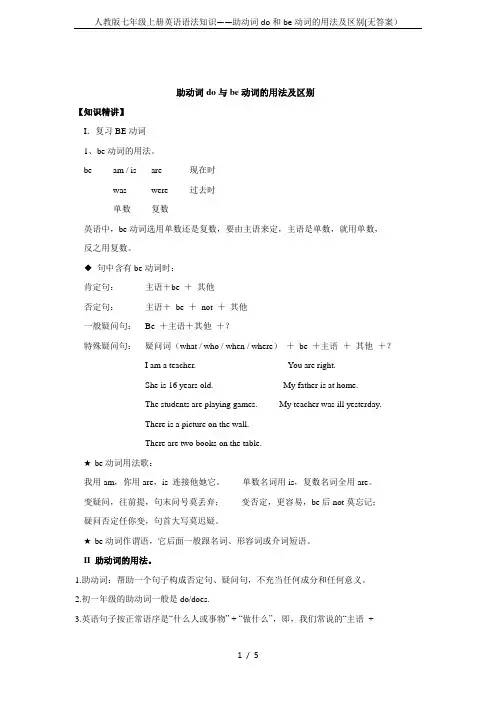
人教版七年级上册英语语法知识——助动词do和be动词的用法及区别(无答案)助动词do与be动词的用法及区别【知识精讲】I.复习BE动词1、be动词的用法。
be am / is are 现在时was were 过去时单数复数英语中,be动词选用单数还是复数,要由主语来定,主语是单数,就用单数,反之用复数。
◆句中含有be动词时:肯定句:主语+be +其他否定句:主语+be +not +其他一般疑问句:Be +主语+其他+?特殊疑问句:疑问词(what / who / when / where)+be +主语+其他+?I am a teacher. You are right.She is 16 years old. My father is at home.The students are playing games. My teacher was ill yesterday.There is a picture on the wall.There are two books on the table.★ be动词用法歌:我用am,你用are,is 连接他她它。
单数名词用is,复数名词全用are。
变疑问,往前提,句末问号莫丢弃;变否定,更容易,be后not莫忘记;疑问否定任你变,句首大写莫迟疑。
★ be动词作谓语,它后面一般跟名词、形容词或介词短语。
II 助动词的用法。
1.助动词:帮助一个句子构成否定句、疑问句,不充当任何成分和任何意义。
2.初一年级的助动词一般是do/does.3.英语句子按正常语序是“什么人或事物” + “做什么”,即,我们常说的“主语+谓语+ 其他”。
但要进行句型转换时,句中谓语为行为动词,就要借助助动词do/does.①主语为I 或复数名词、代词时:肯定句:I / We / They / The students +动词原形+其他+。
We watch TV every night.变否定:主语+don’t +动词原形+其他+。
be动词、助动词、情态动词讲解(基础篇)第一讲
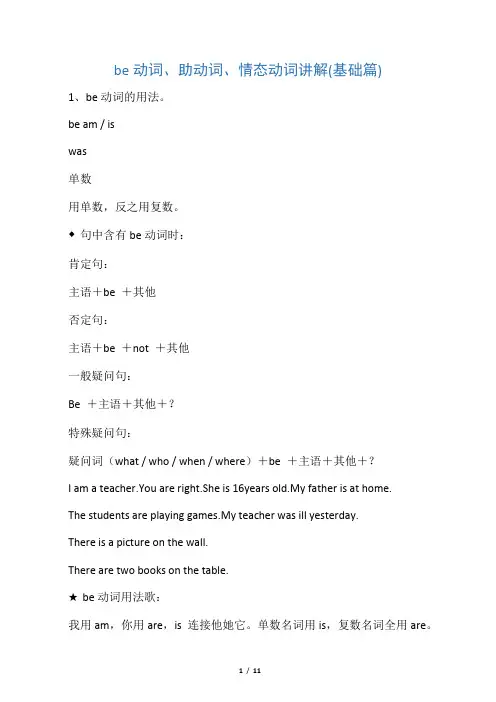
D. are, like
2. A:
How many days __ there in a week?
B:
There __ seven.
A. is, is
B. are, are
C. is, are
D. are, is
3. The boy __ ill today.
A. are
be
1、be动词的用法。
be am / is
was
单数
用单数,反之用复数。
◆句中含有be动词时:
肯定句:
主语+be+其他
否定句:
主语+be+not+其他
一般疑问句:
Be+主语+其他+?
特殊疑问句:
疑问词(what / who / when / where)+be+主语+其他+?
I am a teacher.You are right.She is 16years old.My father is at home.
B. is
C. be
D. am
4. What ___ your father ___?
A. do, like
B. is, like
C. are, likes
D. does, like
5. ___ you go to school by bus?
A. Are
B. Is
C. Do
D. Does
6. When ___ your birthday?
否定句:
主语+ didn’t +动词原形+其他+。
He / We didn’t get up early every morning last year.一般疑问句:
Be动词的形式和用法
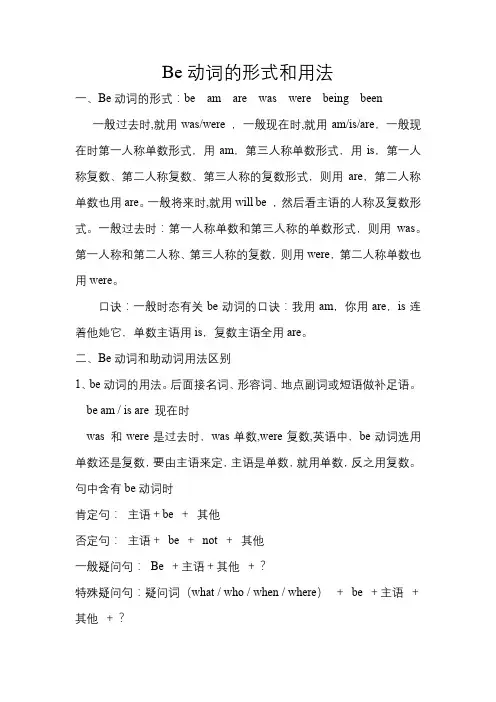
Be动词的形式和用法一、Be动词的形式:be am are was were being been一般过去时,就用was/were ,一般现在时,就用am/is/are,一般现在时第一人称单数形式,用am,第三人称单数形式,用is,第一人称复数、第二人称复数、第三人称的复数形式,则用are,第二人称单数也用are。
一般将来时,就用will be ,然后看主语的人称及复数形式。
一般过去时:第一人称单数和第三人称的单数形式,则用was。
第一人称和第二人称、第三人称的复数,则用were,第二人称单数也用were。
口诀:一般时态有关be动词的口诀:我用am,你用are,is连着他她它,单数主语用is,复数主语全用are。
二、Be动词和助动词用法区别1、be动词的用法。
后面接名词、形容词、地点副词或短语做补足语。
be am / is are 现在时was 和were是过去时,was单数,were复数,英语中,be动词选用单数还是复数,要由主语来定,主语是单数,就用单数,反之用复数。
句中含有be动词时肯定句:主语+be +其他否定句:主语+be +not +其他一般疑问句:Be +主语+其他+?特殊疑问句:疑问词(what / who / when / where)+be +主语+其他+?如:I am a teacher.You are right.She is 16 years old.My father is at home.The students are playing games.My teacher was ill yesterday.There is a picture on the wall.There are two books on the table.be动词用法歌:我用am,你用are,is 连接他她它。
单数名词用is,复数名词全用are。
变疑问,往前提,句末问号莫丢弃;变否定,更容易,be后not莫忘记;疑问否定任你变,句首大写莫迟疑。
助动词do doesdid 和be动词am is are用法的区别
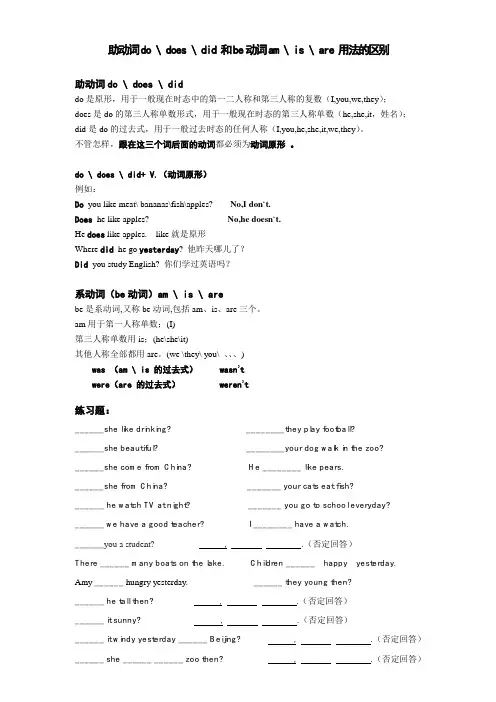
助动词do \ does \ did 和be动词am \ is \ are 用法的区别助动词do \ does \ diddo是原形,用于一般现在时态中的第一二人称和第三人称的复数(I,you,we,they);does是do的第三人称单数形式,用于一般现在时态的第三人称单数(he,she,it,姓名);did是do的过去式,用于一般过去时态的任何人称(I,you,he,she,it,we,they)。
不管怎样,跟在这三个词后面的动词都必须为动词原形。
do \ does \ did+ V.(动词原形)例如:Do you like meat\ bananas\fish\apples? No,I don`t.Does he like apples? No,he doesn`t.He does like apples. like就是原形Where did he go yesterday? 他昨天哪儿了?Did you study English? 你们学过英语吗?系动词(be动词)am \ is \ arebe是系动词,又称be动词,包括am、is、are三个。
am用于第一人称单数;(I)第三人称单数用is;(he\she\it)其他人称全部都用are。
(we \they\ you\ 、、、)was (am \ is 的过去式) wasn’twere(are 的过去式) weren’t练习题:______she like drinking? ________they play football?______she beautiful? ________your dog walk in the zoo?______she come from China? He ________ like pears.______she from China? _______ your cats eat fish?______ he watch TV at night? _______ you go to school everyday?______ we have a good teacher? I ________ have a watch.______you a student? , .(否定回答)There ______ many boats on the lake. Children ______ happy yesterday.Amy ______ hungry yesterday. ______ they young then?______ he tall then? , .(否定回答)______ it sunny? , .(否定回答)______ it windy yesterday ______ Beijing? , .(否定回答)______ she ______ ______ zoo then? , .(否定回答)。
be动词、助动词、情态动词讲解第一讲
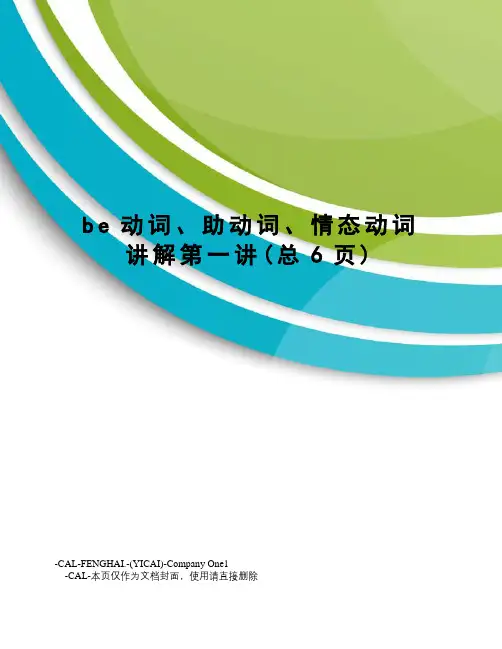
b e动词、助动词、情态动词讲解第一讲(总6页)-CAL-FENGHAI.-(YICAI)-Company One1-CAL-本页仅作为文档封面,使用请直接删除be动词、助动词、情态动词讲解 (基础篇)1、be动词的用法。
英语中,be动词选用单数还是复数,要由主语来定,主语是单数,就用单数,反之用复数。
◆ 句中含有be动词时:肯定句:主语+be +其他否定句:主语+ be + not +其他一般疑问句: Be +主语+其他+特殊疑问句:疑问词(what / who / when / where)+ be +主语+其他+?I am a teacher. You are right.She is 16 years old. My father is at home.The students are playing games. My teacher was ill yesterday.There is a picture on the wall.There are two books on the table.★ be动词用法歌:我用am,你用are,is 连接他她它。
单数名词用is,复数名词全用are。
变疑问,往前提,句末问号莫丢弃;变否定,更容易,be后not 莫忘记;疑问否定任你变,句首大写莫迟疑。
★ be动词作谓语,它后面一般跟名词、形容词或介词短语。
她个子很高。
她在教室里。
她是一个高个子的女孩。
2、助动词的用法。
英语句子按正常语序是“什么人或事物” + “做什么”,即,我们常说的“主语 + 谓语 + 其他”。
① 主语为I 或复数名词、代词时:肯定句: I / We / They / The students +动词原形+其他+。
We watch TV every night.变否定:主语+don’t +动词原形+其他+。
We don’t watch TV every night.一般疑问句 Do + 主语 + 动词原形 + 其他 +Do you watch TV every night?Yes, we do. / No, we don’t.特殊疑问句:疑问词 + do + 主语 + 动词原形 + 其他 +How often do you watch TV?② 主语为单数名词或代词时:肯定句:主语 + 动词第三人称单数形式 + 其他 + 。
助动词dodoesdid和be动词amisare用法的区别
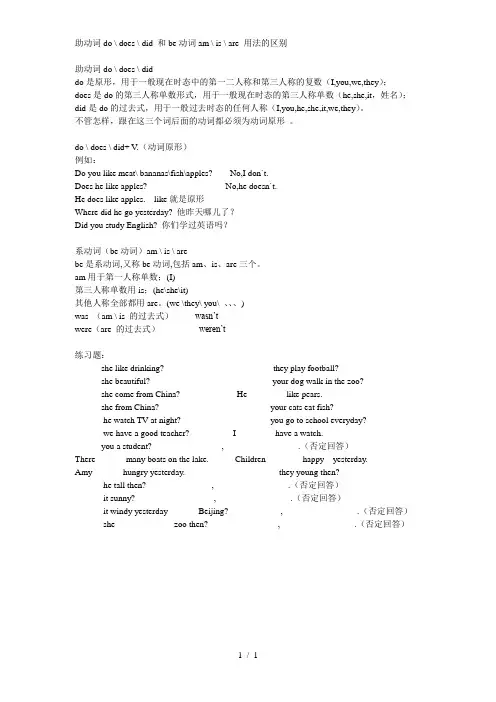
助动词do \ does \ did 和be动词am \ is \ are 用法的区别助动词do \ does \ diddo是原形,用于一般现在时态中的第一二人称和第三人称的复数(I,you,we,they);does是do的第三人称单数形式,用于一般现在时态的第三人称单数(he,she,it,姓名);did是do的过去式,用于一般过去时态的任何人称(I,you,he,she,it,we,they)。
不管怎样,跟在这三个词后面的动词都必须为动词原形。
do \ does \ did+ V.(动词原形)例如:Do you like meat\ bananas\fish\apples? No,I don`t.Does he like apples? No,he doesn`t.He does like apples. like就是原形Where did he go yesterday? 他昨天哪儿了?Did you study English? 你们学过英语吗?系动词(be动词)am \ is \ arebe是系动词,又称be动词,包括am、is、are三个。
am用于第一人称单数;(I)第三人称单数用is;(he\she\it)其他人称全部都用are。
(we \they\ you\ 、、、)was (am \ is 的过去式)wasn’twere(are 的过去式)weren’t练习题:______she like drinking? ________they play football?______she beautiful? ________your dog walk in the zoo?______she come from China? He ________ like pears.______she from China? _______ your cats eat fish?______ he watch TV at night? _______ you go to school everyday?______ we have a good teacher? I ________ have a watch.______you a student? , .(否定回答)There ______ many boats on the lake. Children ______ happy yesterday.Amy ______ hungry yesterday. ______ they young then?______ he tall then? , .(否定回答)______ it sunny? , .(否定回答)______ it windy yesterday ______ Beijing? , .(否定回答)______ she ______ ______ zoo then? , .(否定回答)1 / 1。
英语语法be动词与助动词do用法
说明: 构成否定祈使句只用do,不用did和does。
初一英语:助动词Do和Be在疑问句里怎样选择使用?
如果句子里的谓语是实义动词时,疑问句就要用助动词DO。
For example:
1、I give him a book 。
He doesn't liLeabharlann e to study. 他不想学习。
In the past, many students did not know the importance of English. 过去,好多学生不知道英语的重要性。
3) 构成否定祈使句,例如:
Don't go there. 不要去那里。
is也可与主语缩写,如: He is = He's, My mother is = My mother's等。但是This is不可缩写。而is与not可缩写成 isn't。
如:This isn't a book. 这不是一本书。
根据以上叙述我们可以把动词的用法以口诀的形式表述出来:
我(I)是am,
因为句中give是实义动词,所以这个句子要变为疑问句的话前面就应该用助动词
Do you give him a book .
如:They aren't students. 他们不是学生。但是am与not不能缩写。
3. 如果主语是单数名词、不可数名词或单数第三人称代词(he, she, it)时,be动词用is。
如:My mother is a teacher. 我的妈妈是一名老师。
He is a student. 他是一名学生。
Be动词和助动词的用法区别
Be动词和助动词的用法区别1、be动词的用法。
be am / is are 现在时was were 过去时单数复数英语中,be动词选用单数还是复数,要由主语来定,主语是单数,就用单数,反之用复数。
◆句中含有be动词时:肯定句:主语+be +其他否定句:主语+be +not +其他一般疑问句:Be +主语+其他+?特殊疑问句:疑问词(what / who / when / where)+be +主语+其他+?I am a teacher. You are right.She is 16 years old. My father is at home.The students are playing games. My teacher was ill yesterday.There is a picture on the wall.There are two books on the table.★ be动词用法歌:我用am,你用are,is 连接他她它。
单数名词用is,复数名词全用are。
变疑问,往前提,句末问号莫丢弃;变否定,更容易,be后not莫忘记;疑问否定任你变,句首大写莫迟疑。
★ be动词作谓语,它后面一般跟名词、形容词或介词短语。
2、助动词的用法。
英语句子按正常语序是“什么人或事物” + “做什么”,即,我们常说的“主语+ 谓语+ 其他”。
①主语为I 或复数名词、代词时:肯定句:I / We / They / The students +动词原形+其他+。
We watch TV every night.变否定:主语+don’t +动词原形+其他+。
We don’t watch TV every night.一般疑问句Do + 主语+ 动词原形+ 其他+ ?Do you watch TV every night?Yes, we do. / No, we don’t.特殊疑问句:疑问词+ do + 主语+ 动词原形+ 其他+ ?How often do you watch TV?②主语为单数名词或代词时:肯定句:主语+ 动词第三人称单数形式+ 其他+ 。
be动词、助动词、情态动词讲解(基础篇)第一讲
be 动词、助动词、情态动词讲解(基础篇)1、be 动词的用法。
be am / iswas单数用单数,反之用复数。
♦句中含有be动词时:肯定句:主语+be +其他否定句:主语+be +not +其他一般疑问句:Be +主语+其他+?特殊疑问句:疑问词( what / who / when / where )+be +主语+其他+?I am a teacher.You are right.She is 16years old.My father is at home.The students are playing games.My teacher was ill yesterday.There is a picture on the wall.There are two books on the table.★ be 动词用法歌:我用am,你用are, is连接他她它。
单数名词用is,复数名词全用变are。
疑问,往前提,句末问号莫丢弃;变否定,更容易,be 后not 莫忘记;疑问否定任你变,句首大写莫迟疑。
★ be 动词作谓语,它后面一般跟名词、形容词或介词短语。
她个子很高。
她在教室里。
她是一个高个子的女孩。
2、助动词的用法。
英语句子按正常语序是“什么人或事物” +做“什么”,即,我们常说的“主语+ 谓语+其他” arewere复数现在时过去时英语中,be 动词选用单数还是复数,要由主语来定,主语是单数,就① 主语为I 或复数名词、代词时:肯定句:I / We / They / The students +动词原形+其他+。
We watch TV every night.变否定:主语+ don' t+动词原形+其他+。
We don' t watch TV every night.一般疑问句Do +主语+动词原形+其他+?Do you watch TV every night?Yes, we do./No, we don ' t.特殊疑问句:疑问词+ do + 主语+动词原形+其他+ ? How often do you watch TV?② 主语为单数名词或代词时:肯定句:主语+动词第三人称单数形式+其他+。
Be动词和助动词用法区别
精选文档Be 动词和助动词用法区别:其实be动词也是助动词(auxiliary verbs )。
英语动词大致可分为三种:助动词(auxiliaryverbs ), 情态动词( modal verbs ),实意动词( full verbs )。
助动词(auxiliary verbs ) : do , be, have。
没有实意,“帮助”别的动词,表示时态,否定和提问。
情态动词( modal verbs ): can, must , may 。
也是“帮助”别的动词,但是有自己的实意。
实意动词( full verbs ): play , run , think 。
其他有实意的动词。
be 动词可用作助动词( auxiliary verbs ): 1, be+Ving :所有的进行时态,如: 2, be+ 过去分词:被动式。
be 动词也可用做实意动词( full verbs ): be [bi]v. 有;在;是。
你这样想,一个句子里要有动词吧。
再看看它们的名字,“ be 动词”和“助动词”,先说“ be 动词”,(1 )这名字里有动词,说明他是动词,句子里有他就不会有别的动词(除非这些动词以别的形式出现,这是后话)了,( 2) am,is,are,was,were be"动词,是因为他们是 be的不同形式再说“助动词”,(1)一定要注意“助”,是帮助的意思,说明他不是动词,只是起到了辅助的作用,所以,他们就一定要与动词同时出现。
[记住啊,他们离不开动词,但是动词没有他们也是可以的](2)did,do,does 只是do 的不同形式,根据你所需要的时态来选择(1)用于肯定句 ,否定句和疑问句am :第一人称单数(即只与 I 连用),用于现在时(一般现在,现在进行,只要那时态中是现在的就行)eg: ① I am a girl. 一般现在时② I am eating an apple. 现在进行时③ I am going to do my homework.[ be going to 表将来,将来中只有这一种 ]is :第三人称单数 ,用于现在时(一般现在,现在进行,只要那时态中是现在的就行)(it 就不举例了)般现在时② He/She is eating an apple. 现在进行时eg: ① She/He is a girl/boy.③ He/She is going to do his homework.[ be going to 表将来,将来中只有这一种 ]are :第二人称单数,所有人称复数,用于现在时(一般现在,现在进行,只要那时态中是现在的就行) eg: ① You are a girl.We/You(你们)/They are girls. 一般现在时② You are eating an apple.We/You(你们)/They are eating apples. 现在进行时③ We/You(你们)/They are going to do our/your/their homework.[ be going to 表将来,将来中只有这一种 ] was :第一人称单数,第三人称单数,用于过去时(一般过去,过去进行,只要那时态中是过去的就行)(it 就不举例了)eg:① She/He was a girl/boy. —般过去•时回答be 是一个连系动词,它有自己不同的形式现在时: be 进行时: being 过去时: was/were 过去分词: been 它的后面必须跟形容词或名词作表语,与之构成系表结构,充当句子的谓语。
- 1、下载文档前请自行甄别文档内容的完整性,平台不提供额外的编辑、内容补充、找答案等附加服务。
- 2、"仅部分预览"的文档,不可在线预览部分如存在完整性等问题,可反馈申请退款(可完整预览的文档不适用该条件!)。
- 3、如文档侵犯您的权益,请联系客服反馈,我们会尽快为您处理(人工客服工作时间:9:00-18:30)。
1、be动词的用法。
be am / is are 现在时
was were 过去时
单数复数
英语中,be动词选用单数还是复数,要由主语来定,主语是单数,就用单数,反之用复数。
◆句中含有be动词时:
肯定句:主语+be +其他
否定句:主语+ be + not +其他
一般疑问句: Be +主语+其他+?
特殊疑问句:疑问词(what / who / when / where)+ be +主语+其他+?
I am a teacher. You are right.
She is 16 years old. My father is at home.
The students are playing games. My teacher was ill yesterday.
There is a picture on the wall.
There are two books on the table.
★ be动词用法歌:
我用am,你用are,is 连接他她它。
单数名词用is,复数名词全用are。
变疑问,往前提,句末问号莫丢弃;变否定,更容易,be后not莫忘记;
疑问否定任你变,句首大写莫迟疑。
★ be动词作谓语,它后面一般跟名词、形容词或介词短语。
2、助动词的用法。
英语句子按正常语序是“什么人或事物” + “做什么”,即,我们常说的“主语 + 谓语 + 其他”。
①主语为I 或复数名词、代词时:
肯定句: I / We / They / The students +动词原形+其他+。
We watch TV every night.
变否定:主语+don’t +动词原形+其他+。
We don’t watch TV every night.
一般疑问句 Do + 主语 + 动词原形 + 其他 + ?
Do you watch TV every night?
Yes, we do. / No, we don’t.
特殊疑问句:疑问词 + do + 主语 + 动词原形 + 其他 + ?
How often do you watch TV?
②主语为单数名词或代词时:
肯定句:主语 + 动词第三人称单数形式 + 其他 + 。
He watches TV every night.
否定句:主语+ doesn’t+动词原形+其他+。
He doesn’t watch TV every night.
一般疑问句:Does + 主语 + 动词原形 + 其他 + ?
Does he watch TV every night?
Yes, he does. / No, he doesn’t.
特殊疑问句:疑问词 + does + 主语 + 动词原形 + 其他 + ?
How often does he watch TV?
③过去时的句式(当句子时态为过去时时,动词用过去式,不受主语单复数的影响)
肯定句:主语 + 过去式 + 其他 + 。
He / We got up early every morning last year.
否定句:主语+ didn’t + 动词原形 + 其他 + 。
He / We didn’t get up early every morning last year.
一般疑问句: Did + 主语 + 动词原形 + 其他 + ?
Did he / you get up early every morning last year?
Yes, he / we did. / No, he / we didn’t.
特殊疑问句:疑问词 + did + 主语 + 动词原形 + 其他 + ?
When did he / you get up every morning last year?
(注:文档可能无法思考全面,请浏览后下载,供参考。
可复制、编制,期待你的好评与关注)。
